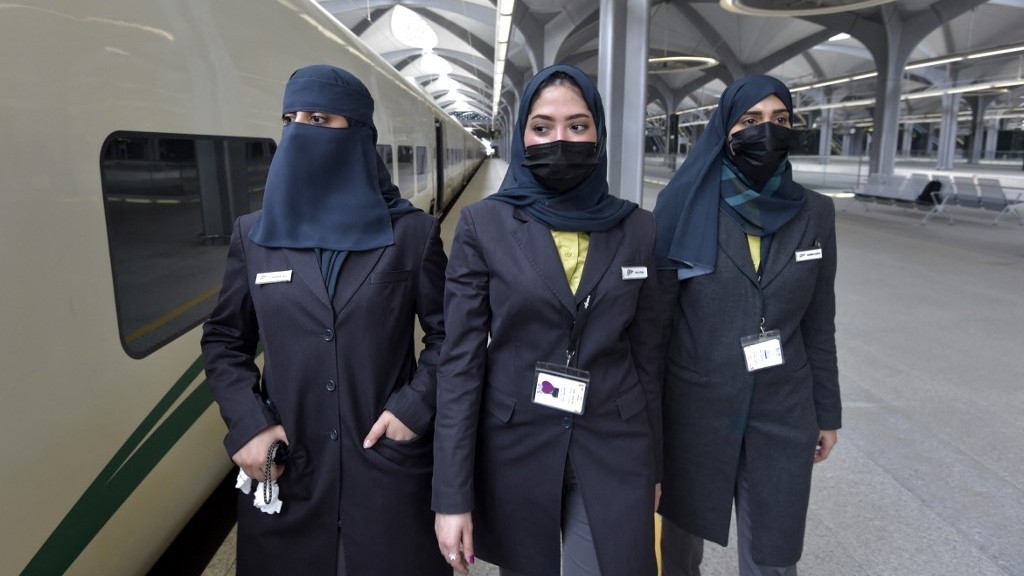Women are joining Saudi Arabia's workforce but still lag behind global average

Saudi Arabia is making progress with women's labour force participation, which has doubled in six years, but is still well below the global average, a panel in Washington said on Thursday.
The kingdom has high income and education levels, but Saudi women's involvement in the workforce is still not as high as expected, experts said during a panel on the economic empowerment of women in Saudi Arabia hosted by the Arab Gulf States Institute (AGSIW) in Washington DC.
Leadership positions are still predominantly held by men.
“I think the past ten years actually have been quite remarkable in terms of women empowerment and production in the workforce,” Eman Alhussein, a non-resident fellow at AGSIW, said. It wasn’t until 2012 that women were allowed to work in retail for the first time and it didn’t come without pushback, she said.
“Even though the increased introduction of women and retail, in the beginning, was slow and small, it was a very important step because it increased the visibility of women and it also normalised their contribution.”
New MEE newsletter: Jerusalem Dispatch
Sign up to get the latest insights and analysis on Israel-Palestine, alongside Turkey Unpacked and other MEE newsletters
Tim Callen, a visiting fellow at AGSIW, said that over the last six years, female labour force participation rates in Saudi Arabia doubled from about 17.5 percent to 35 percent.
The employment of Saudi women increased by 45 percent, while the unemployment rate for Saudi women went from 33 percent to just below 16 percent.
'It's hard to think of a country where women's economic prospects have changed as much as they have in Saudi Arabia over the past 15 years'
- Jennifer Peck, Swarthmore College
“But in terms of the challenges, despite likely what I think is very impressive progress, the female labour force participation rate is still well below the global average... which is just over 50 percent,” Callen said.
“And the female unemployment rate [in Saudi Arabia] is three times higher than the male rate. So you know, impressive progress, but much further to go.”
The increased participation of women in the workforce has a lot to do with social reforms in Saudi Arabia in terms of investing in women’s education, reforming the guardianship system, and lifting the driving ban, Jennifer Peck, an associate professor of economics at Swarthmore College, explained.
“It's hard to think of a country where women's economic prospects have changed as much as they have in Saudi Arabia over the past 15 years. Saudi Arabia has been investing in women's education,” Peck said. “So it's been a long period of ramp up and I think the country is starting to really reap the benefits of this long-term investment.”
In recent years, Saudi Arabia's Crown Prince Mohammed bin Salman has undertaken social reforms in the conservative kingdom but has also stepped up efforts to muffle political dissent, using cybercrime laws to sentence offenders to prison terms for online posts deemed insulting to rulers or threatening to public order.
In August, Saudi Arabia sentenced a secondary schoolgirl to 18 years in jail and a travel ban for posting tweets in support of political prisoners, according to a rights group.
How to move forward
But though there are reforms, the numbers are lacking compared to the rest of the world. Sidra Rehman, an economist at the International Monetary Fund, explained that it’s not as easy as it sounds.
“There can be issues in terms of the supply of women, and there's a limited supply and how do you ensure that there's a pipeline that keeps feeding that? And at the same time, you also don't want to bid up wages too much,” Rehman argued.
While inflation is low and stable and it’s not a concern, she explained, these are hurdles that come about when these initiatives are rolled out.
“Another interesting aspect that we learned from the authorities was on retention of women. How do they enter the labour force? How long are they staying?”
According to Peck, changes in Saudi Arabia have been taking place rapidly. She explained that 15 years is not a long time for changes to take full effect in the labour market. Much of it has to do with support for women who want to have children and have careers.
She added that change doesn't happen overnight and the growth of the childcare industry is a high priority in Saudi Arabia.
"The women want to work and the government wants to support them and to help them find childcare. But the high-quality childcare that people want for their young children is just very scarce. And that's a growing industry, but it's one that you can't grow overnight.”
She explained that in cases like this, it is more important to focus on quality and safety, but understand that it is something that is slower to evolve.
While implementation has been an issue in Saudi Arabia, she explained, it’s important to understand that implementation takes time to kick in. Additionally, there should be more awareness because many working women don’t know about the reforms being made in the kingdom, she said.
“When you look at all of these reforms and all of the space that has been made for this to happen… now it is just going to need some time to grow up around the demand that already exists,” Peck said.
Middle East Eye delivers independent and unrivalled coverage and analysis of the Middle East, North Africa and beyond. To learn more about republishing this content and the associated fees, please fill out this form. More about MEE can be found here.





